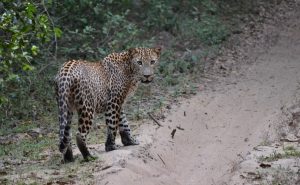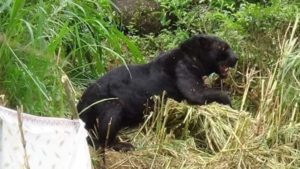The Sri Lankan Leopard (Panthera pardus kotiya)

The Sri Lankan Leopard is a subspecies of the Panthera pardus, and is Endemic to Sri Lanka. It is commonly known as “kotiya”. It is one of the 9 extant subspecies of leopards in the world, Paules Edward Pieris Deraniyagala first described it in 1956.
S.L. Leopard is a digitigrade mammal that uses its clawed toes in locomotion. Although considered as a terrestrial mammal and it is the most arboreal member in its family (Family – Felidae) with several adaptive abilities to support climbing. The most common sightings of leopards feeding and resting are on trees. They are also good swimmers.
Leopards are recorded to have been evolved since the Pleistocene era and distributed around the world. In Sri Lanka, the Leopard (P.p. kotiya) is distributed in most of the forestry patches (except the Western Province) in all habitat zones and in parts of the central highlands. At present due to habitat degradation leopards are recorded within human dwellings and vegetation as well.
Characteristically, the S.L. Leopard has evolved to become a larger subspecies. It has a rusty yellow coat with black spots and close-set rosettes. This provides very good camouflage. There are also melanistic leopards (Black Panther) recorded in the country. In Leopards the melanism is caused by a recessive allele which means even spotted parents have the probability to give birth to melanistic offspring. In Sri Lanka until the recent tragedy of a black leopard caught in a snare in Lakshapana estate, Nallathaniya which later died after being sent for treatment, their records were mostly video-based data caught in motion cameras, before this the last live specimen was found about a decade ago.

Males being fairly larger than females can reach up to 70-80kg, with a head-to-body length of about 4ft and a tail length of about 3ft in a fully grown adult.
The S.L. Leopard is a solitary hunter and also an apex predator due to the absence of predators in the wild and lack of competition from other felines. It marks its territories by spraying urine and leaving scratches on trees. It is a carnivorous mammal, commonly preying on small, young mammals, birds and reptiles; it can knock down larger mammals including the buffalo, wild boar and deer sp. Leopards are mostly nocturnal hunters but they tend to be active in daylight hours. The leopard is a good stalker of prey; it approaches its prey slowly with head low and legs bent, when the prey is a bit separated from the rest and is within striking distance it speeds up itself towards the prey. It usually takes hold of the neck or throat of the prey and tries to drag it to an undisturbed place. When feeding, leopard also uses its tongue to scrape out meat because their tongues are rough and have tiny hooks in them.
Unlike its sympatric sp., the Sri Lanka Sloth bear, which tends to attack when a human is sighted; the leopard usually tries to avoid human interactions. It just walks away without initializing conflict.
There is no specific season for leopard births. The females choose a dominant male for mating so that a strong gene pool be passed on. After a gestation period of about 90 – 100 days, it gives birth to 2-4 young. The cubs are born blind, their eyes begin to open after about 10 days. The females look after the young until they are capable of hunting for themselves. It usually has a life span of 12 – 15 years in the wild and much longer in captivity.
The S.L. Leopard is a potential keystone species and a crucial necessity to maintain food chain balance. Wild boar populations and other ecological pests such as peacock populations are thought to be thriving because of the decrease in leopard numbers. Since 2008 it has been declared as an Endangered species by the IUCN Red List. The major and actually the only threat to Leopards in the country are humans. Habitat destruction and fragmentation; forest lands and adjoining forest lands are being cleared for agricultural and urbanization purposes. It is believed that dissolving the 05/2001 circular will also cause immense loss to not only leopard habitats but also to many fauna and flora species.
Poaching followed by illegal trade; leopards have a spectacular coat and also their claws and teeth hold a high market value in the animal body part trafficking. Snare traps; sometimes they are laid targeting leopards, there have been instances when leopards are found dead in such traps and all their teeth and claws have been removed. At times they are laid in agricultural areas targeting other animals such as wild boars but passing by leopards get trapped in them. Snares are usually fatal, as the animals struggle to free themselves the wire in the snare pierces through their skin in the abdomen region causing a lot of muscle damage. During the last year, 2020, about 11 out of 13 leopard deaths are due to these snares.
The Sri Lankan Leopard is a protected species under the Fauna and Flora Protection Ordinance. The killing of a leopard is subject to fines and imprisonment. And laying of snares is also declared illegal.
Although laws are being enforced, why and how does this still continue?
Several conservation methods have also been implemented. In-situ conservation in National parks such as Yala and nature reserves where there are significant leopard populations. Ex-situ conservation in Zoos including the Dehiwala Zoological Gardens, Pinnawala Zoo, Ritigala Safari park.
The Department of Wildlife Conservation (DWC), and many Non-Governmental organizations and welfare societies are involved to ensure conservation and spread awareness for the importance of this species.

References:
Kittle, A.M., Watson, A.C. and Fernando, T.S.P., 2017. The ecology and behaviour of a protected area Sri Lankan leopard (Panthera pardus kotiya) population. Tropical Ecology, 58(1), pp.71-86.
Kittle, A.M., Watson, A.C., Cushman, S.A. and Macdonald, D.W., 2018. Forest cover and level of protection influence the island-wide distribution of an apex carnivore and umbrella species, the Sri Lankan leopard (Panthera pardus kotiya). Biodiversity and Conservation, 27(1), pp.235-263.
Miththapala, S., Seidensticker, J., Phillips, L.G., Goodrowe, K.L., Fernando, S.B.U., Forman, L. and O’brien, S.J., 1991. Genetic variation in Sri Lankan leopards. Zoo Biology, 10(2), pp.139-146.


